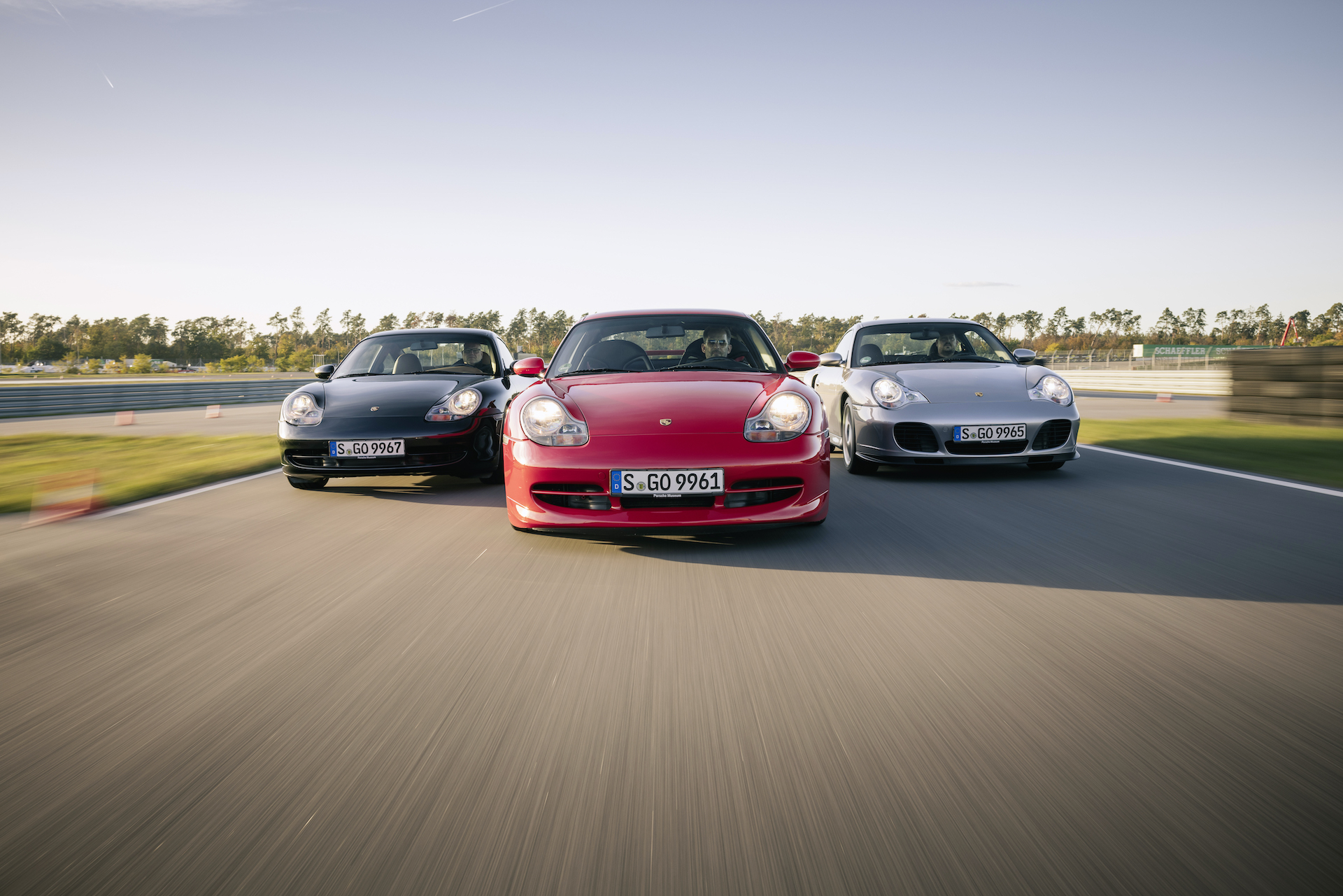Porsche 911 996 – everything you need to know
Fifth-generation Porsche 911
The Porsche 911 996 debuted in 1997 at the IAA in Frankfurt. The fifth-generation Porsche 911 broke with several conventions. With the exception of the highly modified iconic 911 design and the powertrain concept with the engine in the rear, everything was new. No longer air-cooled, the 996 was water-cooled and shared several components with the Boxster. The two models were virtually identical up to the B-pillars and in terms of the interior. What remained was the principle of the six-cylinder boxer engine.
Porsche in lower price segment
August Achleitner was strategically responsible for the overall 996 concept between 1989 and 2000. “Porsche needed a car in a lower price segment to ensure a higher sales volume. So the idea of swapping parts from the 986 Boxster and the 996 was born.”

Even tried a V8 engine
There was no question that the new 911 had to look like a 911 – but which engine would be in the back was not initially clear. “We experimented with the engine. Air-cooled designs with two valves per cylinder were technologically at the end of their rope in terms of emissions and power. And air-cooled boxers with four valves didn’t work for various reasons. In 1989, a compact V8 was even mounted in the rear as a trial, but that idea was also discarded. So that brought us to water-cooled four-valve boxer engines.”
Design Porsche 911 996
The design of the 996 was developed in the 1990s under the direction of Dutch design boss Harm Lagaaij. “It was a challenging task. But we succeeded by first designing a number of different Boxster/996 versions.” Due to lack of time, Porsche started building 1:1 models right away. Lagaaij’s team grew to eighty members at its peak to accelerate the work.

Best of Show
That the 996 and Boxster resembled from the front the Boxster study model that Porsche presented at the 1993 Detroit Motor Show is due to the success of that concept car. The Boxster study model got the public’s hands on it and was even named “Best of Show” in Detroit. “It was immediately clear to me: the nose of the study model also fit the 996,” Lagaaij says.
The team worked simultaneously on all three versions – the 996, 986 and the concept car. Chief designer Lagaaij was well aware of the risk of mixing up the 996 and 986 Boxster models, but he had other concerns. “The pressure and need to save the company was the top priority.”

Mirror egg headlights
Internally, there was little criticism of the concept and design – but the “mirror egg” headlights did not appeal to the media. This came as a complete surprise to the designers; after all, the design had been praised in the Boxster concept car. “The design was totally unique: featuring high beam, low beam, fog light, turn signal and a headlight washer in one unit that was inexpensive and could be installed on the assembly line within minutes,” Lagaaij explained.

Variants Porsche 911 996
Porsche introduced the Cabriolet in April 1998 with a fully electric hood that raised or lowered in twenty seconds. Opened, it disappeared under a metal cover plate, eliminating the need for a tonneau cover. About six months later, Porsche complemented the duo with a four-wheel-drive 911 Carrera 4 as a Coupe and Cabriolet version – each with the bodywork of the base 911.
This Carrera 4 and the 305 km/h fast four-wheel-drive 911 Turbo that was available from January 2000 with its 420 hp bi-turbo engine were planned from the beginning. “When designing the 996, we made the transmission tunnel large enough to make it suitable for all-wheel drive. The Boxster also had that center tunnel, although it was never available with four-wheel drive.”

Porsche 911 GT3 and 911 GT2
While the Turbo and Carrera 4 models were planned from the outset, the 911 GT3 launched by Porsche in May 1999 came about almost by accident. As motorsport regulations changed, Porsche built a 360-hp version as a road homologation car as the successor to the 911 Carrera RS. “The economic success and numbers were not great initially,” Achleitner reveals. “Yet the 911 GT3 was the beginning of its own brand – because with the 996 GT3 we created a version that made a clear difference between an everyday 911 and a street version inspired by motorsport.” This was followed in January 2001 by the 911 GT2 based on the 911 Turbo with a 3.6-liter boxer engine with 462 horsepower – the first model with standard ceramic brakes.

911 996 facelift in 2002 model year
Porsche made a number of modifications on the 996 for the 2002 model year. Displacement increased to 3.6-liter and power to 320 hp. The 911 Targa and the 911 Carrera 4S Coupe with the wider body of the 911 Turbo joined the family. The 4S version with sunroof followed in 2003. For the 2004 model year, Porsche also offered a convertible version of the Turbo and – as one of several special models – the 911 Carrera Coupe “40 Years of Porsche 911” with 345 hp, a sport suspension and an electric sunroof. Starting with the 2005 model year, the Turbo S was available as a Coupe and Cabriolet with 450 hp. Never before have there been as many variants of the 911 as in the 996 generation.

Approximately 175,000 copies
According to August Achleitner, the program was planned so that Porsche could sell a total of at least 30,000 of the two models with good returns. “That was also the reason why the Boxster was launched in 1996 – a year before the 996.” The plan worked: the first water-cooled 911 was a worldwide success. Porsche sold about 175,000 units of the 996 between 1997 and 2005. Used ones are still quite pricey, but with a “Porsche Approved” stamp you can be sure of a correct maintenance history.



